Physical Address
304 North Cardinal St.
Dorchester Center, MA 02124
Atlantoaxial joint opening, manual manipulation of the facets, denuding of the articular cartilage, packing of bone graft into the joint cavity, and direct screw fixation of the facets of atlas and axis form a biomechanically strong mode of atlantoaxial stabilization and a background for segmental arthrodesis.
Reduction of basilar invagination can be performed by distraction of the facets of atlas and axis in a specific group of patients.
Basilar invagination is secondary to and a delayed consequence of atlantoaxial instability. Atlantoaxial stabilization is the treatment.
Apart from alteration in atlantodental interval and direct neural compression by the odontoid process, atlantoaxial instability can be identified by observing the facetal alignment and also by manual handling of bones during surgery.
Chiari I formation and syringomyelia with or without bone abnormalities at the craniovertebral junction are secondary phenomena, and their pathogenesis is related to long-standing atlantoaxial instability.
Atlantoaxial instability can be associated with or can even be a nodal point of pathogenesis of more common cervical pathologies like cervical spondylosis, cervical kyphotic deformities, and ossification of posterior longitudinal ligament.
Musculoskeletal events like short neck, torticollis, platybasia, and Klippel-Feil abnormality are external manifestations of atlantoaxial instability.
The craniovertebral junction is a structural masterpiece of nature designed to be the most stable and the most mobile region of the body and architectured to provide an uncompromising and safe passage to the most critical neural and vascular structures. Occipitoatlantal and atlantoaxial joints compose the craniovertebral junction zone. The atlantoaxial joint is the most mobile joint of the body, is active in saying both yes and no, and moves tirelessly and flawlessly throughout the life. On the other hand, the occipitoatlantal joint is one of the most stable joints of the body; it has steel-like ligaments and functions to keep the head on the shoulders and connected with the spine throughout life. To provide for maximum and circumferential movements at the atlantoaxial joint, the facetal surfaces of the atlas and axis are designed flat and round and are positioned in the form of block of bricks. Although the structure of the atlantoaxial joint is crafted for maximal and unrestricted movements, it is also most prone to instability. In the craniovertebral junction, the atlantoaxial joint is the center for movement and is also the center for instability. It may not be incorrect to state that all craniovertebral junction instability can be referred to as atlantoaxial instability . Occipitoatlantal instability is rare and can be associated with an extreme degree of trauma. Less commonly occipitoatlantal instability can be a part of a multiple joint affection that is associated with syndrome ligamental laxity more often seen in the pediatric age group. Rheumatoid arthritis, tuberculosis, and tumors can also affect the stability of the occipitoatlantal joint. In general, surgery for craniovertebral junction stabilization essentially means atlantoaxial stabilization.
The subject of craniovertebral junction anomalies has been under discussion and evaluation for over a century. A large array of complex bony and neural anomalies has been described in this region. It now appears that the craniovertebral “anomalies” are not congenital abnormalities related to embryologic dysgenesis but are a natural response, adaptations or alterations that aim to protect the neural structures from the consequences of instability of the atlantoaxial joint.
Atlantoaxial dislocation (AAD) can be due to a number of etiologic factors. The dislocation has been classified into the mobile and reducible type or the fixed or irreducible type. However, the current concept is that fixed or irreducible type of dislocation does not exist and the atlantoaxial joints in the so-called irreducible type of AAD (except in extremely rare situations where the joints fuse in a dislocated position) are not only not fused but are mobile, have pathologically abnormal mobility, and are reducible by manual manipulation that includes direct facetal distraction. This concept has revolutionized the treatment of atlantoaxial dislocation, which now focuses on stabilizing the joint rather than decompressing the neural structures by transoral route or by foramen magnum decompression.
The odontoid process of the axis is normally in close approximation with the anterior arch of the atlas. In AAD, the atlas dislocates ventrally on the axis on flexion of the head, widening the atlantodental interval and reducing the diameter of the spinal canal, with consequent pressure on the cervicomedullary junction cord. The dislocation increases on flexion of the head and reduces in extension in the mobile variety of AAD. Atlantoaxial dislocation was diagnosed when the atlantodental was more than 3 mm on flexion of the head. In children, the atlantodental interval of 3 to 5 mm is sometimes considered to be within the range of normalcy. The entire treatment protocol of craniovertebral junction instability was based on this premise for over 50 years.
Atlantoaxial dislocation can also be identified on the basis of facetal alignments in the neutral head position on lateral or sagittal profile imaging ( Fig. 34.1 ). In type 1 instability, the facet of atlas dislocates anterior to the facet of axis. Such dislocation and positioning of the facets of atlas and axis mimic that of the vertebral bodies in lumbosacral spondylolisthesis. In this form of instability, the odontoid process is displaced posteriorly, the atlantodental interval is increased, and the odontoid process compresses the neural structures. In type 2 facetal instability, the facet of atlas is displaced posterior to the facet of axis. In type 3 facetal instability, the facets of atlas and axis are in alignment. The instability in such cases is recognized by associated radiologic and clinical features and is confirmed only during operation by direct and manual handling of bone structures. The atlantodental interval may not be affected, the odontoid process may not directly compress the neural structures, and the subarachnoid spaces around the cord in the craniovertebral junction may be entirely normal in types 2 and 3 facetal instability. The atlantoaxial instability in types 2 and 3 is also referred to as central or axial instability . The symptoms are relatively acute in type 1 facetal instability and more chronic in types 2 and 3 instability. Evaluation of atlantoaxial instability on the basis of facetal alignment has expanded in scope and opened up a new chapter in our understanding of the subject.
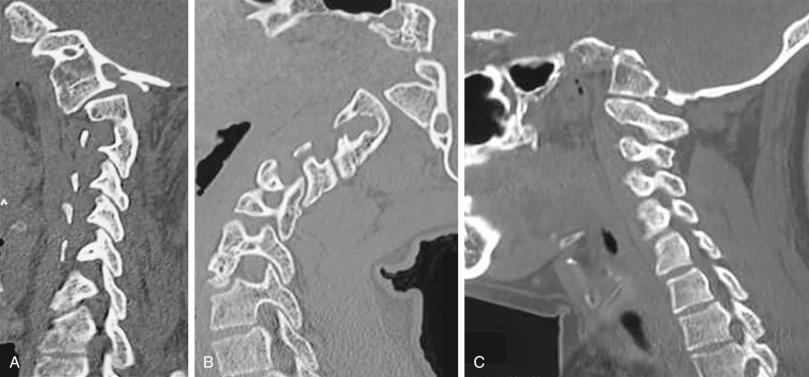
Vertical mobile and reducible atlantoaxial dislocation wherein there is basilar invagination when the neck is flexed and the alignment is normal when the head is in an extended position. Although such mobility is relatively less common, it does indicate the need for dynamic flexion—extension studies to preoperatively assess the craniovertebral instability. Vertical dislocation is due to the incompetence of the atlantoaxial joint and lateral masses.
In 2001 the author and colleagues analyzed 160 cases with mobile and reducible atlantoaxial dislocation treated in our department from 1988 to 2001. Although trauma leads to mechanical disruption of ligaments of the region, in congenital dislocation and dislocation related to known syndromes, laxity or incompetence of the ligaments is more often the cause.
Pain and spasm in the upper part of the neck and restriction of neck movements are common symptoms. The patient may give a history of an injury that flexed the head and neck (such as when one is hit on the back of the head) as the precipitating factor. Weakness and spasticity of all limbs can follow the event of trauma. A range of motor and sensory deficits can occur. The sensory deficits are relatively less severe. Severe injuries to the cervicomedullary cord may produce quadriparesis/quadriplegia, respiratory paralysis, coma, and even death.
Dynamic plain lateral radiographs, computed tomography (CT) scans, and magnetic resonance imaging (MRI) of the craniovertebral junction with the head in flexed and extended positions show the alteration in the atlantodental interval and confirm atlantoaxial instability in anteroposterior and vertical perspectives ( Fig. 34.2 ). CT scan and MRI provide useful information regarding the nature of primary and associated bone and soft tissue alterations. MR and CT angiography show the relationship of the vertebral artery to the facets of C2 and C1. Such information can be crucial when lateral mass fixation techniques are employed. Three-dimensional (3D) CT scanning and 3D model reconstruction are emerging as useful imaging modalities. The 3D models can replicate the exact lifelike structure of the region. The operative subtleties and instrumentation can be identified, rehearsed, and practiced prior to surgery.
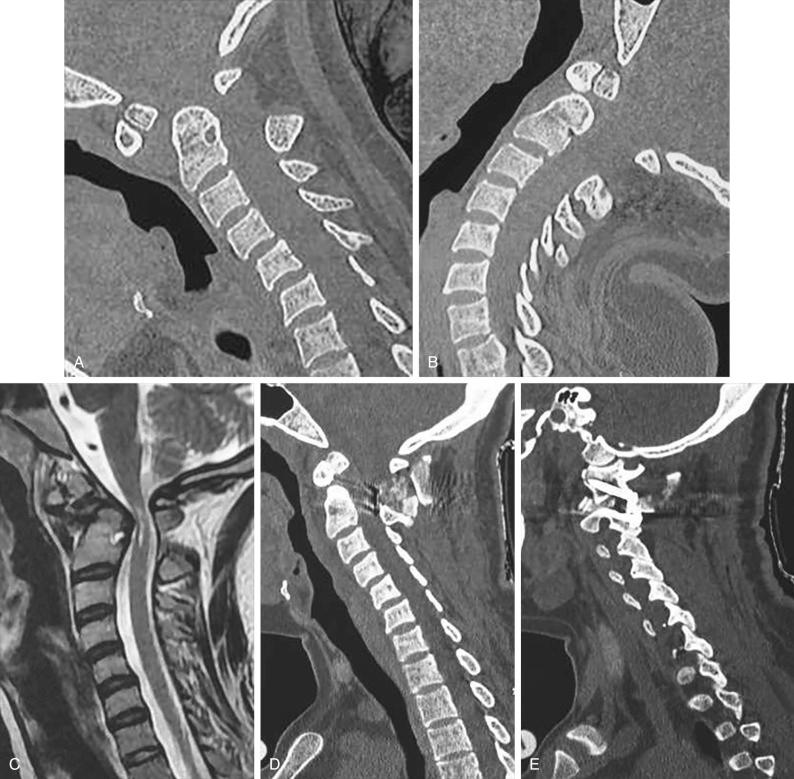
The surgical management of craniovertebral anomalies is complex due to the relative difficulty of accessing the region, the critical relationships of neurovascular structures, and the intricate biomechanical issues involved. The techniques of craniovertebral fixation evolved during the latter quarter of the 20th century as the anatomy and biomechanics of the craniovertebral region became clearer. The aim of surgery is to achieve stability of the atlantoaxial joint and to restore normal or the best possible alignment. The techniques of fixation for atlantoaxial dislocation can be divided into midline procedures that involve the fixation of the arch of the atlas with the lamina of axis and lateral mass fixation procedures . Midline methods of fixation include the use of interlaminar clamps, Gallie posterior C1–C2 sublaminar wiring, Brooks-Jenkins fusion, and the Sonntag technique of sublaminar wiring. Lateral mass fixation procedures include Goel's C1 lateral mass and C2 pedicle/pars screw fixation (inter-facetal) and the Magerl's C1–C2 transarticular technique. The lateral mass fixation techniques have been identified to be biomechanically stronger when compared to techniques that involve fixation of the midline structures like the lamina and arch of atlas. This is because the facets are the center points or the fulcrum of movements in the region.
It is not neural deformation but repeated microtrauma due to instability that is the prime cause of symptoms. Although restoration of altered shape of the neural structures is important, stabilization of the atlantoaxial joint is the prime issue in management. Metal implants provide an initial period of fixation of the region. Bone fusion takes about 3 months, and the metal implants should be strong enough to hold the region for that period and provide a zero movement environment. It ultimately depends on bone fusion to provide stability to the region and to hold the implant in position. Several authors have identified bone harvested from the patient's own iliac crest to be superior to any other form of bone graft or artificial material.
The C1 and C2 vertebrae, called atypical vertebrae, have a unique shape and architecture and a characteristic vertebral artery relationship. The artery has multiple loops and an intimate relationship with the atlas and axis bones. The shape, size, and location of the vertebral artery groove on the inferior aspect of the superior articular facet of the C2 and over the posterior arch of the atlas have wide variations. Throughout its course, the vertebral artery is covered with a large plexus of veins. The venous plexuses are the largest in the region of the lateral gutter posterior to the C1–C2 joint. After a relatively linear ascent of the vertebral artery in the foramen transversarium of C6 to C3, the artery makes a loop medially toward an anteriorly placed superior articular facet of the C2 vertebra, making a deep groove on its inferior surface. The extent of medial extension of the loop varies. Goel first identified that the twists and turns of vertebral artery in the craniovertebral junction provide the possibility of a dynamic relationship such that the vertebral artery stretches on one side and buckles on the contralateral side during twisting of neck. The presence of venous congestion provides support to the arterial movements, and veins dilate and empty on head turning and twisting.
The dens or the odontoid process is flanked by two large superior facets, extending laterally onto the adjoining pars interarticularis and articulating with the inferior atlantal facets. The superior facet of the C2 vertebra differs from the facets of all other vertebrae in two important characters. First, the superior facet of C2 is present in proximity to the body when compared to other facets, which are located in proximity to the lamina. Second, the vertebral artery foramen is present partially or completely in the inferior aspect of the superior facet of C2, whereas in other cervical vertebrae, the vertebral artery foramen is located entirely in relationship with the transverse process. Unlike superior facets of all other vertebrae, they do not form a pillar with the inferior facets, being considerably anterior to them. The course of the vertebral artery in relationship to the inferior aspect of the superior articular facet of the C2 makes it susceptible to injury during transarticular and interarticular screw implantation techniques. The inferior facet of the atlas and superior facet of the axis are almost flat and circular without any significant difference in the mean anteroposterior and transverse (15 mm) dimensions.
Cervical traction is set up after the induction of anesthesia. The weights applied for traction are approximately 5 kg or one-sixth of the total body weight. The patient is placed prone with the head end of the table elevated to about 35 degrees ( Fig. 34.3 ). Cervical traction stabilizes the head in an optimally reduced extension position and prevents any rotation. The traction also ensures that the weight of the head is directed superiorly toward the direction of the traction and pressure over the face or eyeball by the headrest is avoided. The head is in a “floating” position, with the headrest being placed only for additional or minimal support and to prevent unwanted head rotation. Elevation of the head end of the table, which acts as a counter traction, helps to reduce venous engorgement in the operative field. The suboccipital region and the upper cervical spine are exposed through an approximately 8-cm longitudinal midline skin incision centered on the spinous process of the axis. The spinous process of the axis is identified, and the attachment of paraspinal muscles to it is sharply sectioned. The large second cervical ganglion is closely related to the vertebral artery on its lateral aspect ( Fig. 34.4 ). It is first exposed widely and then elevated superiorly to expose the facet joint. Whenever necessary for expanding the exposure of the lateral masses, the ganglion can be sectioned sharply. The understanding of the fact that the sectioning of the C2 ganglion is safe and can be exploited for obtaining or enhancing the exposure of the lateral masses has opened the window to the atlantoaxial joint and has widened the scope of lateral mass fixation techniques. Bleeding from the large venous sinuses in the region and in the extradural space can be troublesome. Subperiosteal dissection and packing of the region with Surgicel and Gelfoam can help to control venous bleeding. The joint capsule is cut sharply, and the articular surfaces of the facets are exposed. The adjacent synovial articular surfaces of the atlantoaxial joint are decorticated widely with an osteotome or a microdrill, and pieces of bone harvested from the iliac crest are stuffed into the joint space. The lateral aspect of the lamina and a part of the pars of the axis are drilled to make the posterior surface of the lateral mass of the axis relatively flat so that the metal plate/rod can be placed snugly and parallel to the bone. Drilling also helps in reducing the length of the plate and in placing the screw more superiorly and almost directly into the lateral mass of the axis. Actual vertebral artery exposure is unnecessary either lateral to the pars of the axis or superior to the arch of the atlas.
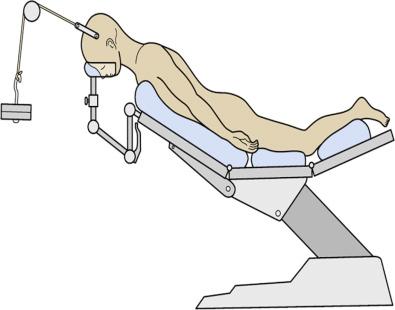
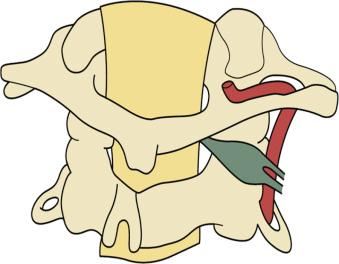
Screws are implanted into the previously created guide holes in the lateral mass of the atlas and axis through a two-holed (approximately 1.5 cm in length) metal (titanium) plate. First, a screw is placed into the atlas. It is directed at an angle of approximately 15 degrees medial to the sagittal plane and 30 degrees superior to the axial plane. The preferred site of screw insertion is at the center of the posterior surface of the facet of atlas, 1 to 2 mm above the articular surface. The screw may even be implanted by choosing an insertion point on the articular surface of the facet of the atlas. Screws can also be implanted into the facet of atlas through the lateral aspect of the posterior arch of the atlas. Due to the intimacy of vertebral artery relationships, screw implantation in the axis needs to be precise. The screw implantation in the superior facet of the C2 vertebra has to be sharply medial and directed toward the anterior tubercle of the anterior arch of atlas. The pars interarticularis can be divided into nine quadrants ; the superior and medial compartments are generally most suited and safe for screw implantation. The medial surface of the pedicle of the axis is identified before the implantation of the screw. The screw is directed at an angle of approximately 25 degrees medial to the sagittal plane and 15 degrees superior to the axial plane. The angle of screw insertion varies, depending on the local anatomy and the size of the bones. The quality of cortical/cancellous bone in the lateral masses of the atlas and axis in the proposed trajectory of screw implantation is generally good, providing an excellent purchase of the screw, and avoids the vertebral artery. The screws used are 2.9 mm in diameter in adult patients and 2.7 mm in diameter in pediatric patients. The approximate lengths of the screws are 26 to 28 mm in adults and 22 to 26 mm in children. The screws in the atlas and axis are almost similar in their dimensions. The lateral masses of the atlas and axis are firm and cortical in nature, and, although preferable, it is not mandatory that the screws engage both the posterior and anterior cortices. If the screw traverses beyond the anterior cortex, it will lie harmlessly in the anteriorly displaced soft tissue. Intraoperative navigation was found to be helpful but not essential in determining the site and direction of the screw insertion ( Fig. 34.5 ). Large pieces of corticocancellous bone graft from the iliac bone are then placed over the adequately prepared posterior elements of the atlas and axis. After the wound is closed, cervical traction is discontinued. The patients are mobilized as soon as possible and advised to wear a hard cervical collar for 3 months.
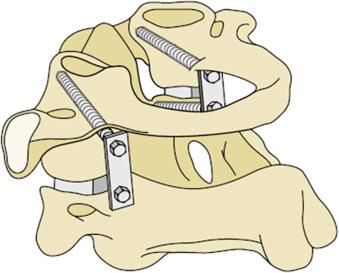
The lateral mass plate and screw fixation technique can provide an opportunity to manipulate the atlas and axis independently by obtaining fixation points with their screw purchase in the strong cortical elements and hence has versatile applications.
Control of sometimes furious venous bleeding in the region of the lateral gutter in an appropriate fashion forms the baseline for a successful surgery. The most dreaded complication of the procedure is injury to the vertebral artery. Injury to the artery during surgery can lead to catastrophic intraoperative bleeding, and compromise to the blood flow can lead to unpredictable neurologic deficits, which will depend on the adequacy of blood flow from the other arteries of the brain. The vertebral artery can be injured during the process of dissection in the lateral gutter in the region of the C2 ganglion. Whenever possible, an attempt must be made to identify and suture the rest in the artery. When the bleeding is excessive, identification of the bleeding point amid venous and arterial bleeding can be a formidable problem. Sacrifice of the artery is the only solution in most cases. The other potential injury may occur when making the hole for inserting the screw into the axis. In the latter situation, to control the bleeding, the most preferred solution is to use the same hole and hurriedly implant and tighten the screw. On most occasions, this maneuver will stop the bleeding. Plugging of the bleeding hole with bone wax or with Surgicel are other available methods to stop the bleeding.
Magerl's technique of fixation involves use of transarticular lateral mass screws. This technique involves stabilization of the atlantoaxial facets with a single long screw that is inserted into the region of pars pedicle of the lateral mass of axis and traverses through the joint into the substance of the facet of the atlas. The method continues to be popular and is a satisfactory method of stabilization.
An alternative method of atlantoaxial fixation that combines Magerl's transarticular method of fixation and the Goel interfacetal fixation technique has been labeled the double insurance fixation technique. The technique combines the biomechanical strengths of both of the more commonly used techniques of fixation and provides maximal stability to the implants ( Fig. 34.6 ).
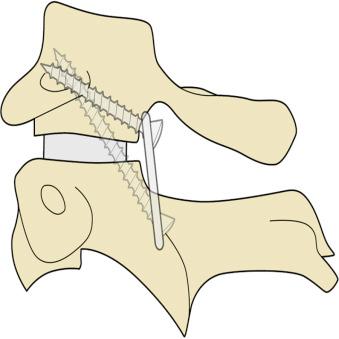
Jamming of spiked spacers within the atlantoaxial joints after distraction of the facets can provide a satisfactory method of atlantoaxial fixation. The joint jamming technique can be suitable in cases where the atlantoaxial dislocation is not remarkably mobile. This method of fixation can usually be employed as a supplement to other techniques of fixation or when other methods are not possible (technically or anatomically) or have failed.
Placement of screws in the large and stubby spinous process, in the spinolaminar junction, or in the lamina has been described to provide a stable fixation point for the axial end of the atlantoaxial fixation construct. Insertion of screws into the inferior facet of the axis can also form a stable and safe site. These fixation points can be used for atlantoaxial or occipitoaxial fixation when lateral mass screw insertion is not possible due to restrictions imposed by the vertebral artery or by other technical issues related to axial point of screw insertion.
Opening of the joint, denuding of the articular cartilage, direct manual manipulation and distraction of the facets of atlas and axis, and placement of bone graft within the joint cavity, with or without the additional support of metallic spacers, can result in significant or complete reduction of the dislocation. Subsequently, atlantoaxial fixation that can sustain the reduction is carried out. It is more important to stabilize the atlantoaxial joint and achieve arthrodesis than to reduce the dislocation and realign the craniovertebral junction.
Basilar invagination forms a prominent component of the craniovertebral abnormalities. Chiari formation and syringomyelia are common neural associates of basilar invagination.
Become a Clinical Tree membership for Full access and enjoy Unlimited articles
If you are a member. Log in here